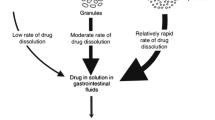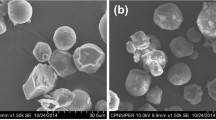Abstract
The study was aimed to formulate an extended release matrix tablets of celecoxib and to investigate the influence of different types and concentration of polymers on release of drug. Six formulations namely F1 – F6 were manually designed using different proportions of polymers. The matrix tablets formulations (F1 – F5) were composed of using different polymers such as, hydroxypropyl methylcellulose (HPMC-K4M), carboxymethyl cellulose (CMC), ethylcellulose (EC-10 cps) and Carbopol-940, whereas plain tablets formulation (F6) without polymer contained microcrystalline cellulose (MCC), lactose monohydrate, sodium lauryl sulfate (SLS) and polyvinylpyrrolidone (PVP-K30). The MCC, SLS and PVP-K30 were used in a fixed quantity in all formulations except F6 i.e. 20.7%, 6.7%, and 2%, respectively. Multiple point dissolution was performed in phosphate buffer of pH 7.4. Dissolution profiles indicated that formulations F2 and F3 extended the drug release up to the desired time period of 12 h. DD Solver (an add-in software for MS Excel) was used to analyze the dissolution profile data for drug release kinetics such as first order, Zero-order, Higuchi and Korsmeyer–Peppas models. However, formulation (F3) containing HPMC – K4M as a matrix former showed concentration-independent drug release as highest linearity was observed when zero-order model was applied (R2 = 0.933). Release mechanism of formulations F3 was super case-II transport. Fourier transform infrared spectroscopy (FTIR) was used to assess the drug polymers compatibility and no drug– excipients interaction was found. The present study accomplished that ethylcellulose and HPMC can be used successfully to develop an extended release matrix tablet formulation.


Similar content being viewed by others
References
Nasiri MI, Yousuf RI, Shoaib MH, Fayyaz M, Qazi F, Ahmed K (2016) Investigation on release of highly water soluble drug from matrix-coated pellets prepared by extrusion–spheronization technique. J Coat Technol Res 13(2):333–344
James HP, John R, Alex A, Anoop K (2014) Smart polymers for the controlled delivery of drugs – a concise overview. Acta Pharm Sin B 4(2):120–127
Siepmann J, Kranz H, Bodmeier R, Peppas N (1999) HPMC-matrices for controlled drug delivery: a new model combining diffusion, swelling, and dissolution mechanisms and predicting the release kinetics. Pharm Res 16(11):1748–1756
Reynolds TD, Gehrke SH, Hussain AS, Shenouda LS (1998) Polymer Erosion and Drug Release Characterization of Hydroxypropyl Methylcellulose Matrices. J Pharma Sci 87(9):1115–1123
Barakat NS, Elbagory IM, Almurshedi AS (2009) Controlled-release carbamazepine matrix granules and tablets comprising lipophilic and hydrophilic components. Drug Deliv 16(1):57–65
Perez-Marcos B, Iglesias R, Gomez-Amoza J, Martinez-Pacheco R, Souto C, Concheiro A (1991) Mechanical and drug-release properties of atenolol-Carbomer hydrophilic matrix tablets. J Control Release 17(3):267–276
Aulton M (2002) Taylor K. Pharmaceutics-The science of dosage form design.Churchill Livingstone, London
Agrawal S, Soni N, Jain NK, Agrawal G (2012). Int J Pharma Sci Res 3(7):2325
Tive L (2000) Celecoxib clinical profile. Rheumatology 39:21–28
Paulson SK, Vaughn MB, Jessen SM, Lawal Y, Gresk CJ, Yan B, Maziasz TJ, Cook CS, Karim A (2001) Pharmacokinetics of celecoxib after oral administration in dogs and humans: effect of food and site of absorption. J Pharmacol Exp Ther 297(2):638–645
Gong L, Thorn CF, Bertagnolli MM, Grosser T, Altman RB, Klein KE (2012) Celecoxib pathways. Pharmacogenet Genom 22(4):310–318
USP35-NF30 (2013) The United States Pharmacopeial Convention, USA
Mathur N, Kumar R, Tiwari K, Singh S, Fatima N (2015). World J Pharm Pharmaceut Sci 4(7):976–984
Saleem A, Nasiri MI, Zaheer K, Anwer S, Ali T, Sarwar H, Azeem M, Naqvi SS (2018). Lat Am J Pharm 37(12):2476–2481
Primo FT, Fröhlich P (2005). Lat Am J Pharm 24(3):421
Saha R, Sajeev C, Jadhav P, Patil S, Srinivasan N (2002) Determination of celecoxib in pharmaceutical formulations using UV spectrophotometry and liquid chromatography. J Pharmaceut Biomed Anal 28(3–4):741–751
Chandran S, Ravi P, Saha RN (2006) Yakugaku zasshi 126(7):505-514
Biswas BK, Islam MS, Begum F, Rouf ASS (2008). Dhaka Univ J Pharma Sci 7(1):39–45
Wise DL (2000) Handbook of pharmaceutical controlled release technology. CRC press
Caço AI, Varanda F, Pratas de Melo MJ, Dias AM, Dohrn R, Marrucho IM (2008). Ind Eng Chem Res 47(21):8083–8089
Alekseev K, Blynskaya E, Tikhonova N, Alekseev V, Uvarov N, Chernova O (2012) Polymers in the formulation of drug dosage forms with modified release. Russ J Gen Chem 82(3):564–571
Iwata M, Ueda H (1996) Dissolution Properties of Glibenclamide in Combinations with Polyvinylpyrrolidone. Drug Dev Ind Pharm 22(11):1161–1165
Chowdary KPR, Ramesh KVR (1995). Indian drugs 32(10):477–483
Enzian G (1972). Pharm Acta Helv 47:321–363 [in French]
Wallace CJT, Shangraw RF (1983). Pharm Technol 7(9):94–104
Omray A, Omray P (1986). Indian J Pharm Sci 48:20–22
Lachman L, Lieberman HA, Kanig JL (1976) The theory and practice of industrial pharmacy: Lea & Febiger Philadelphia
Raza M, Naqvi SBS, Nasiri MI, Ali T, Zaheer K, Saleem A, Sarwar H, Azeem M (2018). RADS J Pharm Pharmaceut Sci 6(2):152–156
Teja SB, Patil SP, Shete G, Patel S, Bansal AK (2016). J Excipients Food Chem 4(3):1048
Gupta P, Thilagavathi R, Chakraborti AK, Bansal AK (2005) Molecular pharmaceutics 2(5): 384-391
Tiwari SB, Murthy TK, Pai MR, Mehta PR, Chowdary PB (2003) Controlled release formulation of tramadol hydrochloride using hydrophilic and hydrophobic matrix system. AAPS PharmSciTech 4(3):18–23
Kaur D, Raina A, Singh N (2014). Int J Pharm Pharm Sci 6:434–440
Zhang Y, Huo M, Zhou J, Zou A, Li W, Yao C, Xie S (2010) DDSolver: An Add-In Program for Modeling and Comparison of Drug Dissolution Profiles. The AAPS J 12(3):263–271
Nasiri MI, Yousuf RI, Shoaib MH, Zaheer K, Ali T, Ahmed K, Qazia F, Anwer S (2019). J Coat Technol Res 13(2):333–344
Qazi F, Shoaib MH, Yousuf RI, Nasiri MI, Ahmed K, Ahmad M (2017) Lipids bearing extruded-spheronized pellets for extended release of poorly soluble antiemetic agent—Meclizine HCl. Lipids Health Dis 16(1):75
Mostafavi A, Emami J, Varshosaz J, Davies NM, Rezazadeh M (2011) Development of a prolonged-release gastroretentive tablet formulation of ciprofloxacin hydrochloride: Pharmacokinetic characterization in healthy human volunteers. Int J Pharm 409(1–2):128–136
Acknowledgments
Authors are thankful to M/S Genome Pharmaceuticals Limited Hattar, Pakistan for providing active pharmaceutical ingredient. Authors also thankful to the Department of pharmaceutics, Riphah International University, Islamabad, Pakistan, for providing laboratory facilities, equipment, and their valuable guidance, support, and cooperation.
Funding
This work was not supported by any funding awarding body. It was purely author’s funded project.
Author information
Authors and Affiliations
Corresponding author
Ethics declarations
Conflict of interest
The authors declared no conflict of interests.
Additional information
Publisher’s note
Springer Nature remains neutral with regard to jurisdictional claims in published maps and institutional affiliations.
Rights and permissions
About this article
Cite this article
Saleem, M.U., Nasiri, M.I., Zaman, Su. et al. Formulation development and characterization of cellulose/ polyacrylic acid – based polymers on the release of celecoxib from extended release tablets. J Polym Res 27, 234 (2020). https://doi.org/10.1007/s10965-020-02201-6
Received:
Accepted:
Published:
DOI: https://doi.org/10.1007/s10965-020-02201-6




